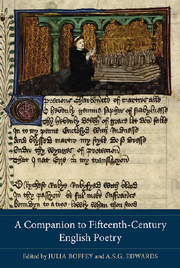2 - Forms of Circulation
from Part I - Background and Context
Published online by Cambridge University Press: 05 July 2013
Summary
Just as the verse of fifteenth-century poets such as Lydgate and Hoccleve was heavily indebted to Chaucer's model for its themes, subjects and forms, so too were its modes of circulation influenced by Chaucerian texts and manuscripts. An important model for the format and layout of the verse manuscripts of his followers was the Ellesmere manuscript of the Canterbury Tales (HEH, MS EL 26.C.9), a de luxe and authoritative copy of the work, produced in London in the first decade of the fifteenth century. In addition to its expansive use of white space, illuminated initials and the provision of a series of pilgrim miniatures at the beginnings of tales, the Ellesmere manuscript gives prominence to a body of Latin marginal source glosses and references that contribute to the presentation of Chaucer as a learned auctor (Parkes 1976; Doyle and Parkes 1979). The influence of the Ellesmere manuscript is most apparent in the layout and appearance of the earliest copies of Hoccleve's major work, Regiment of Princes. Hoccleve's Regiment survives in a total of forty-six manuscripts; the two earliest and textually most authoritative copies, BL, MS Harley 4866 and Arundel 38, were both produced in London in the early fifteenth century and employ very similar features of layout. Individual stanzas are separated by blank lines, with decorated paragraph marks indicating their beginnings, and Latin glosses have been added within the margins; new sections of text are accompanied by decorated borders.
- Type
- Chapter
- Information
- A Companion to Fifteenth-Century English Poetry , pp. 21 - 32Publisher: Boydell & BrewerPrint publication year: 2013



